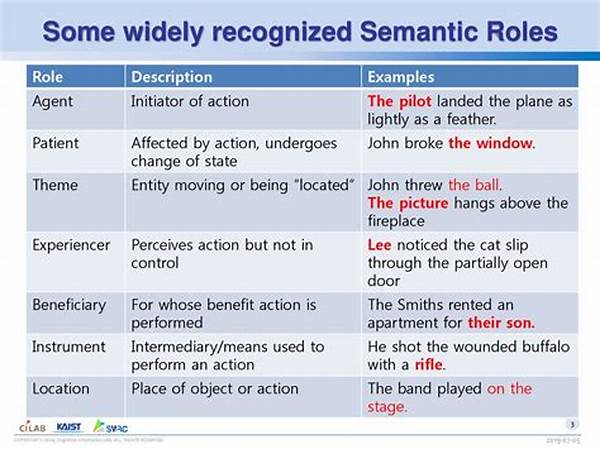Semantic Role Labeling Methods
Semantic Role Labeling (SRL) is a fascinating concept in the world of Natural Language Processing (NLP) that seeks to understand who did what to whom, when, where, and why within any given sentence. It’s like giving a verb its entourage; essentially, you’re assigning roles to each word or phrase in a sentence to understand its function in relation to the action taking place. Imagine wanting to explain a movie scene to a friend, highlighting who the main characters are, what they are doing, and why they are critical to the scene. That’s semantic role labeling in a nutshell. This innovative method makes understanding language as intuitive as discussing your favorite film over a casual coffee. But, how exactly is this accomplished? What are the semantic role labeling methods that make this kind of analysis possible?
Semantic role labeling methods have been transforming how we interpret and interact with text data. At a high level, SRL involves identifying and assigning a semantic role to each constituent of a sentence, such as who is the agent, what is the action, and what is the object of the action, among others. This process is crucial for machines to comprehend human language more naturally. It’s like giving words in a sentence their rightful place in a play, ensuring the storyline is cohesive and compelling. Understanding SRL methods can give businesses a competitive advantage in fields like customer service, smart assistants, and automated content creation, offering them the ability to predict and fulfill customer needs almost preemptively.
Delving deeper into the fascinating world of semantic role labeling methods, it is evident that various approaches contribute significantly to the field. From rule-based systems, which rely on a set of pre-defined linguistic rules, to statistical methods that leverage large corpora to derive patterns and connections, each offers unique strengths and insights. These methods aren’t just theoretical; they’re practical tools that can be applied across numerous industries to enhance the way digital systems process and interpret language. Whether it’s improving the efficiency of a chatbot or aiding in the analysis of customer feedback, the implications of SRL are as vast as they are promising.
Advantages of Semantic Role Labeling Methods
Semantic role labeling methods are not just exclusive to tech enthusiasts and linguistic experts; they offer a suite of advantages that extend to everyday business and personal applications. By integrating these methods into AI systems, companies can achieve deeper, more nuanced understanding and processing of text, enabling more dynamic and intelligent interactions with users and freeing up human resources for higher-order tasks. It’s like upgrading from a basic translator to a fully-fledged linguistic diplomat.
Purpose and Future of Semantic Role Labeling Methods
The purpose of semantic role labeling methods in today’s tech landscape is akin to laying out a roadmap for machines to truly understand and interpret human language. Imagine a travel guide meticulously explaining every culture and tradition to ensure you have an unforgettable experience. SRL does the same for sentences, breaking down each component to provide a comprehensive understanding.
At the heart of SRL is the need to facilitate better human-computer interaction. As digital conversations become increasingly seamless, machines must interpret context as accurately as possible. By employing semantic role labeling methods, we enable computers to provide more accurate, contextually relevant responses, paving the way for innovations in AI-driven personal assistants and customer service bots.
Expanding the Horizons of AI with Semantic Role Labeling
In a world where businesses are driven by data and customer interaction, semantic role labeling methods are like the secret ingredient to success. They are the backbone of AI’s ability to understand natural language, providing insights that drive decision-making processes in real-time. These methods transform simple text into valuable insights, akin to turning raw data into gold.
The Journey Continues
The journey of semantic role labeling methods is far from over; it’s like an epic saga that’s continually unfolding. As research advances, these methods become more sophisticated, refining their ability to discern intricate details within language. Moreover, ongoing improvements mean these tools are becoming increasingly accessible, moving beyond labs and into the hands of developers and businesses eager to make the next leap in AI innovation.
Actions to Implement Semantic Role Labeling Methods
By keeping these actions in mind, businesses can tap into the full potential of semantic role labeling methods and stay ahead in the competitive digital landscape.

